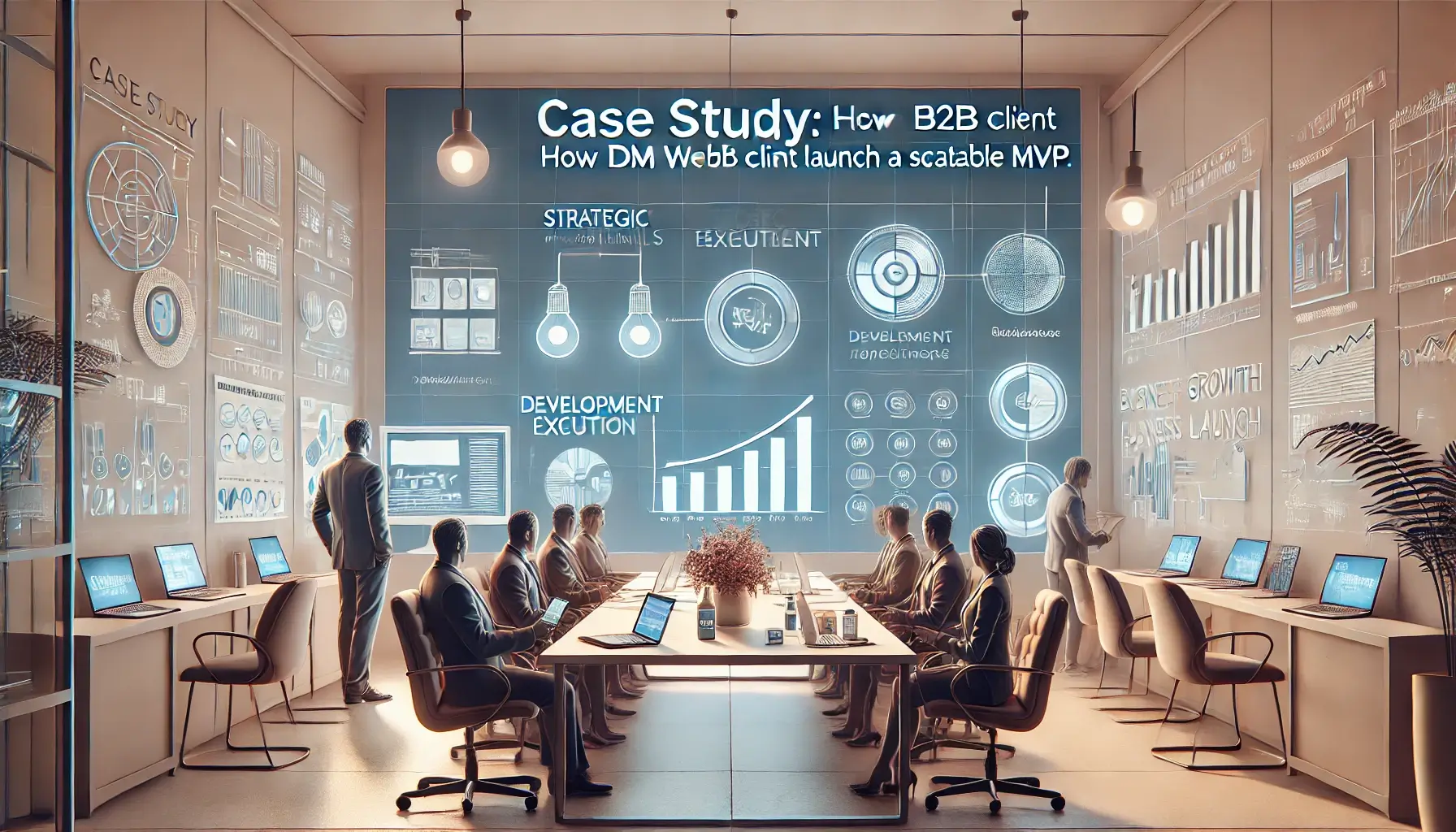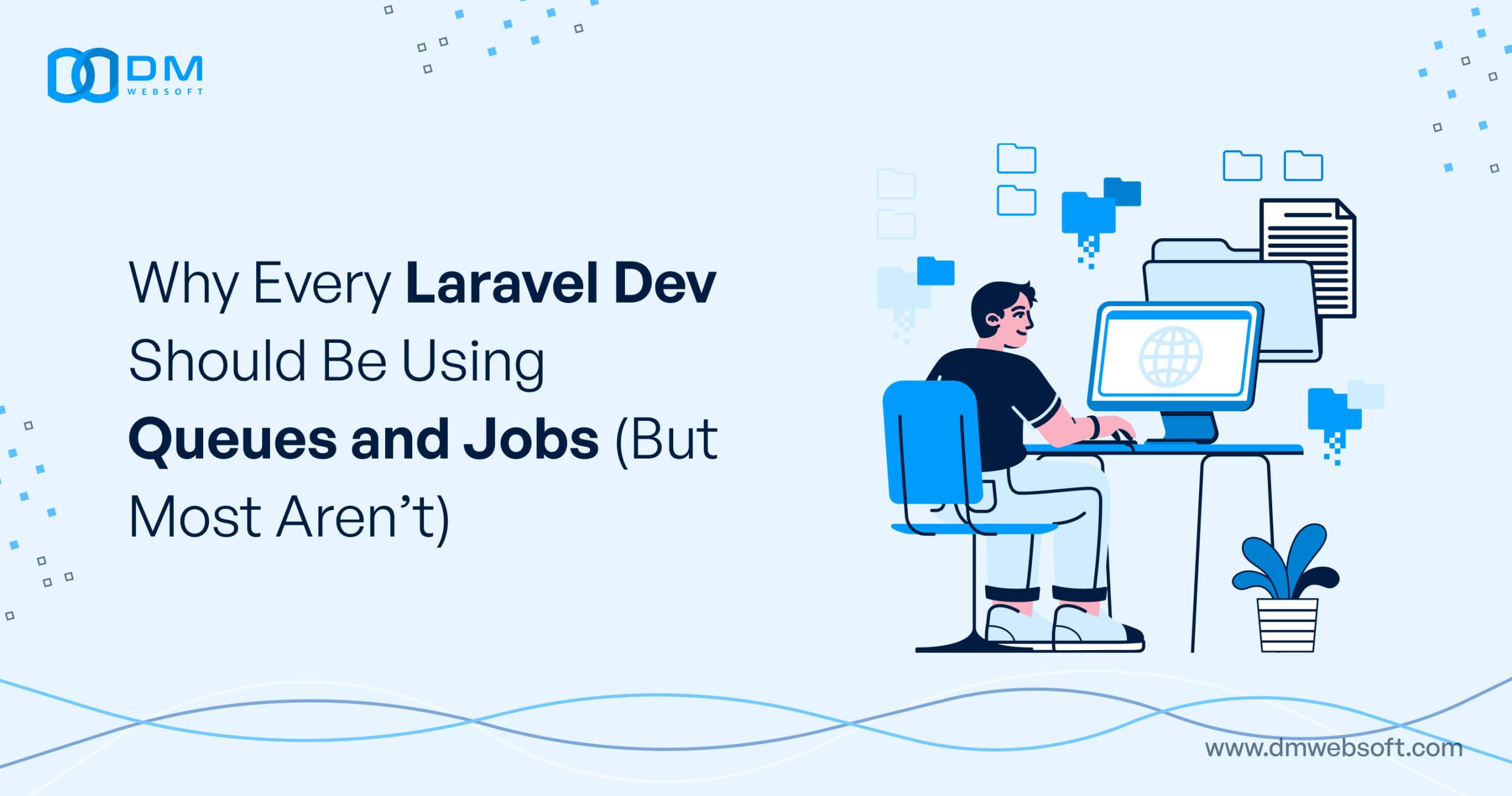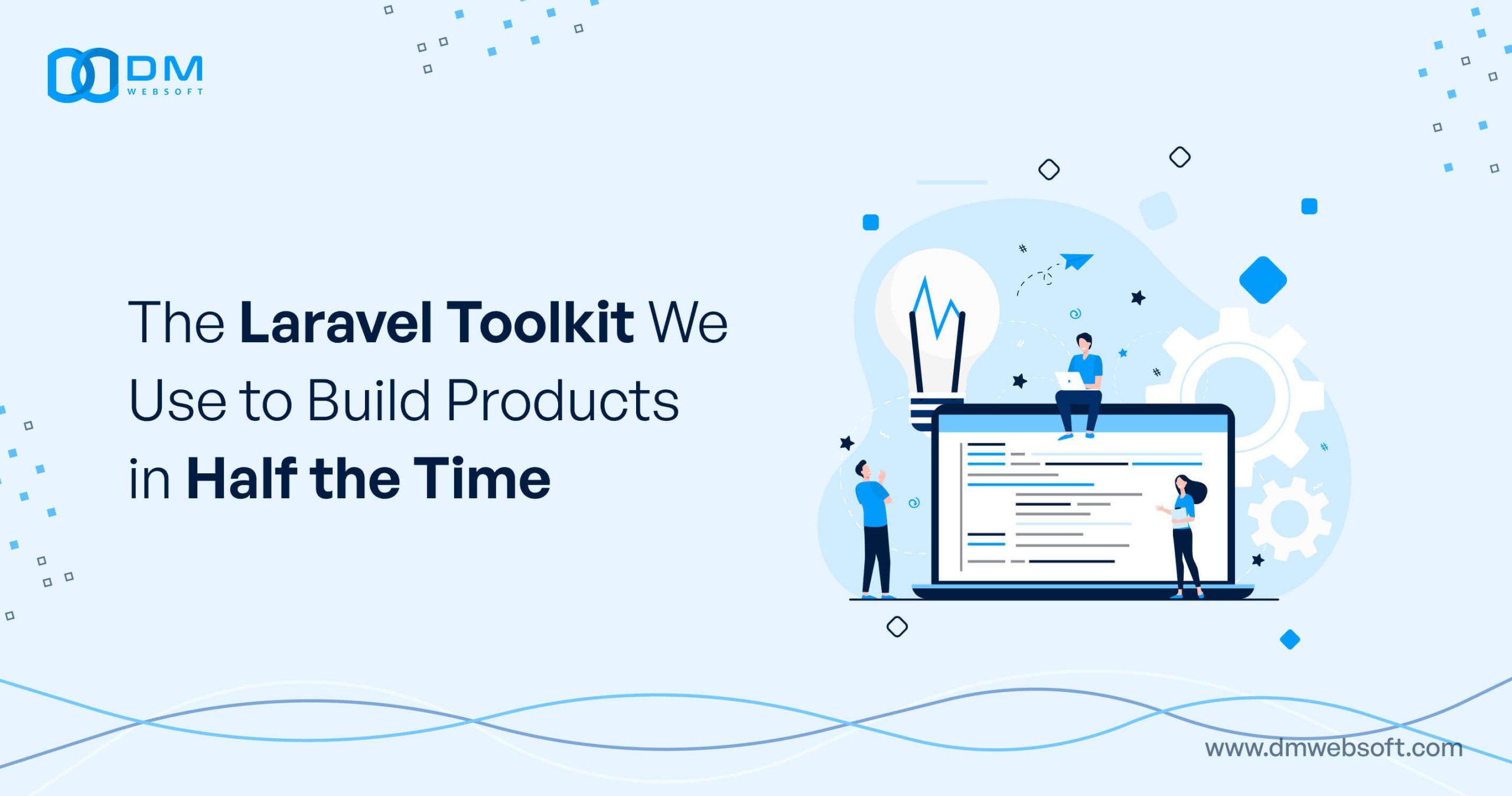DM WebSoft LLP exceeded our expectations! Their seasoned team of experts delivered a website that perfectly captures our brand essence. Their 15+ years of experience truly shine through in their exceptional web development skills.
The B2B MVP Blueprint: Why Business Products Need Different Rule

TABLE OF CONTENT
Introduction
Why B2B MVPs Are Different from B2C MVPs
Key Steps to Building a Successful B2B MVP
Common Challenges in B2B MVP Development
The Role of Agile Methodology in B2B MVP Development
Case Study: How DM WebSoft LLP Helped a B2B Client Launch a Scalable MVP
How to Validate a B2B MVP Before Full-Scale Development
Conclusion: Why B2B Startups Need a Different MVP Blueprint
Get in Touch
Introduction
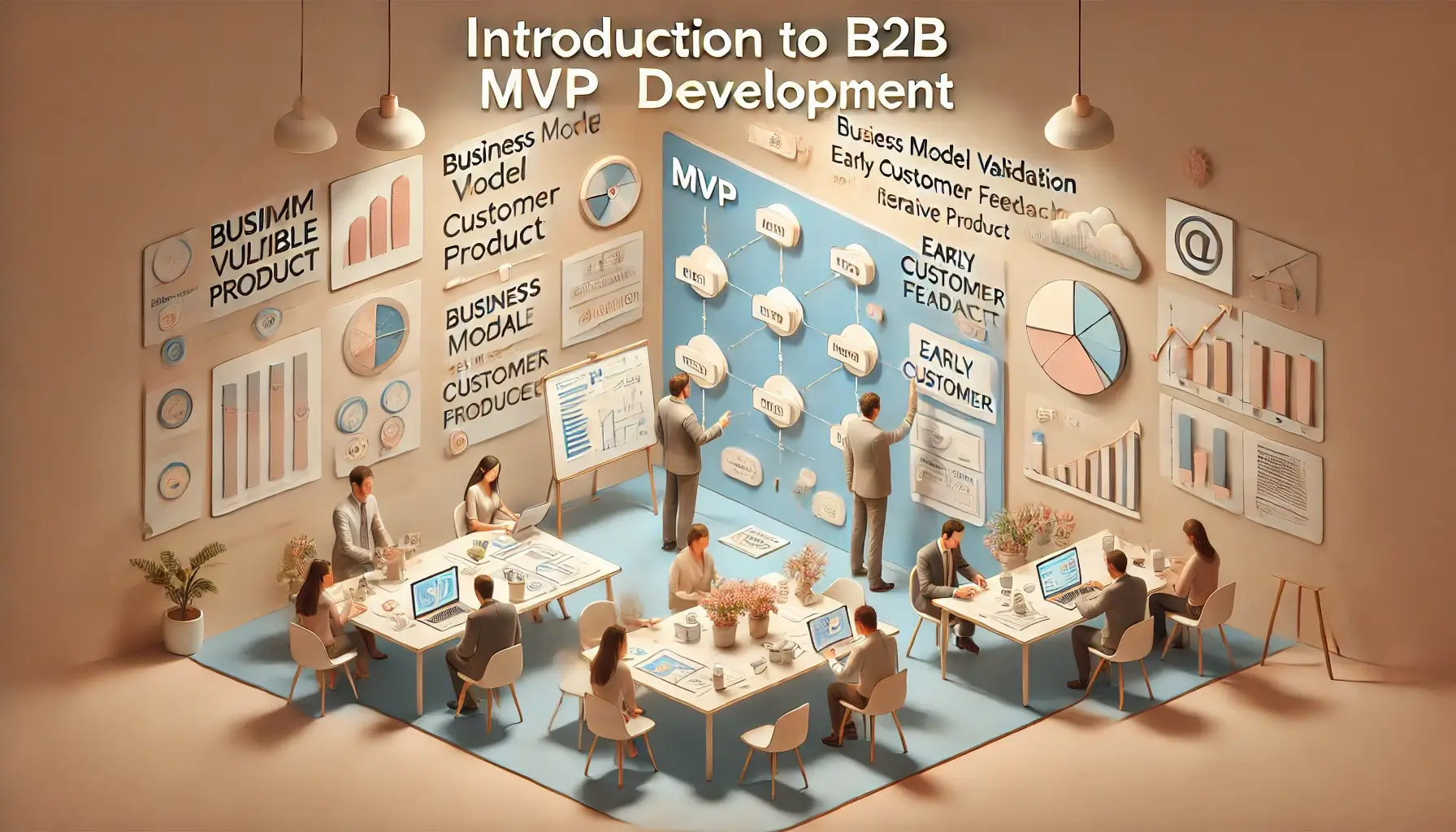
Building a minimum viable product (MVP) is a critical part of any startup, but when creating a B2B (business-to-business) product, taking a traditional B2C (business-to-consumer) MVP model isn’t necessarily applicable. In contrast to direct-to-consumer platforms and consumer-facing applications, B2B products have a high-stakes environment with sophisticated buyers, long sales cycles, and a concern for function over form.
Many B2B startups fail to gain traction because they build MVPs with a B2C bias—chasing looks, virality, and quick adoption at the expense of business-critical capabilities, feedback from customers, and long-term scalability. Instead of shipping with a stripped-down offering optimized for quick adoption, B2B companies first have to deliver mission-critical capabilities for enterprise buyers, with an MVP that generates real business value from day one.
Another key differentiation is in purchasing behavior for B2B buyers. Where a B2C user will download an app and make a decision in a matter of minutes about whether or not they like it, an enterprise buyer will require long demos, approval through many hands, and demonstration of return on investment (ROI) before buying. What that involves is not testing an idea, but proving its value in a complex, commercial environment.
At DM WebSoft LLP, we specialize in creating B2B products and have helped companies navigate the unique challenge of developing high-leverage, scalable MVPs. In this article, we will cover why a B2B MVP will require a different approach, the most critical steps in developing a successful business MVP, and mistakes to avoid.
Why B2B MVPs Are Different from B2C MVPs

Many startups fall into a fallacy that an MVP is a stripped-down version of a completed product, but in B2B, it doesn’t work in most cases. Unlike with B2C goods, whose purpose is widespread use and contagious growth, in B2B, high function, reliability, and value in use are critical in a matter of real value to companies. Enterprise buyers don’t use tools for cool factors and buzz, but for tools that actually deliver value, save them money, and enable them to work smarter, not harder.
One major difference between B2B and B2C MVPs is in sales cycles. In a B2C scenario, a user can try an app, make a decision in a matter of minutes, and use it regularly or not at all. In a B2B scenario, purchases involve several decision-makers, long evaluation times, and procurement processes in a formal manner. What this means is that even an MVP for a B2B scenario must have enough substance in its first build in order to pass an enterprise-level review. If an MVP isn’t sophisticated enough, with critical integration, companies will reject it outright.
Another challenge is that B2B users have a larger function expectation. Consumer apps can launch with a minimum viable, stripped-back product and iterate, but enterprise buyers require tools that integrate with existing workflows, meet requirements, and have reliable service and support. That doesn’t leave a lot of room for experimenting with lightweight concepts and having to build out important, business-critical capabilities first.
Additionally, scalability at even MVP level is an issue in B2B. Even at MVP, multi-user capabilities, complex workflows, and security requirements for information are demanded by companies. Unless a sound technical foundation is in place, a product will not make it when companies try to scale it.
The most successful B2B MVPs value function over form, providing value in terms of ROI-based value propositions and not through consumer-facing attraction. DM WebSoft LLP helps companies tackle such specific impediments through value-scalable, strategic MVPs that cater to an enterprise’s requirements. In the following section, we will break down key steps towards developing a high-impact B2B MVP.
Key Steps to Building a Successful B2B MVP
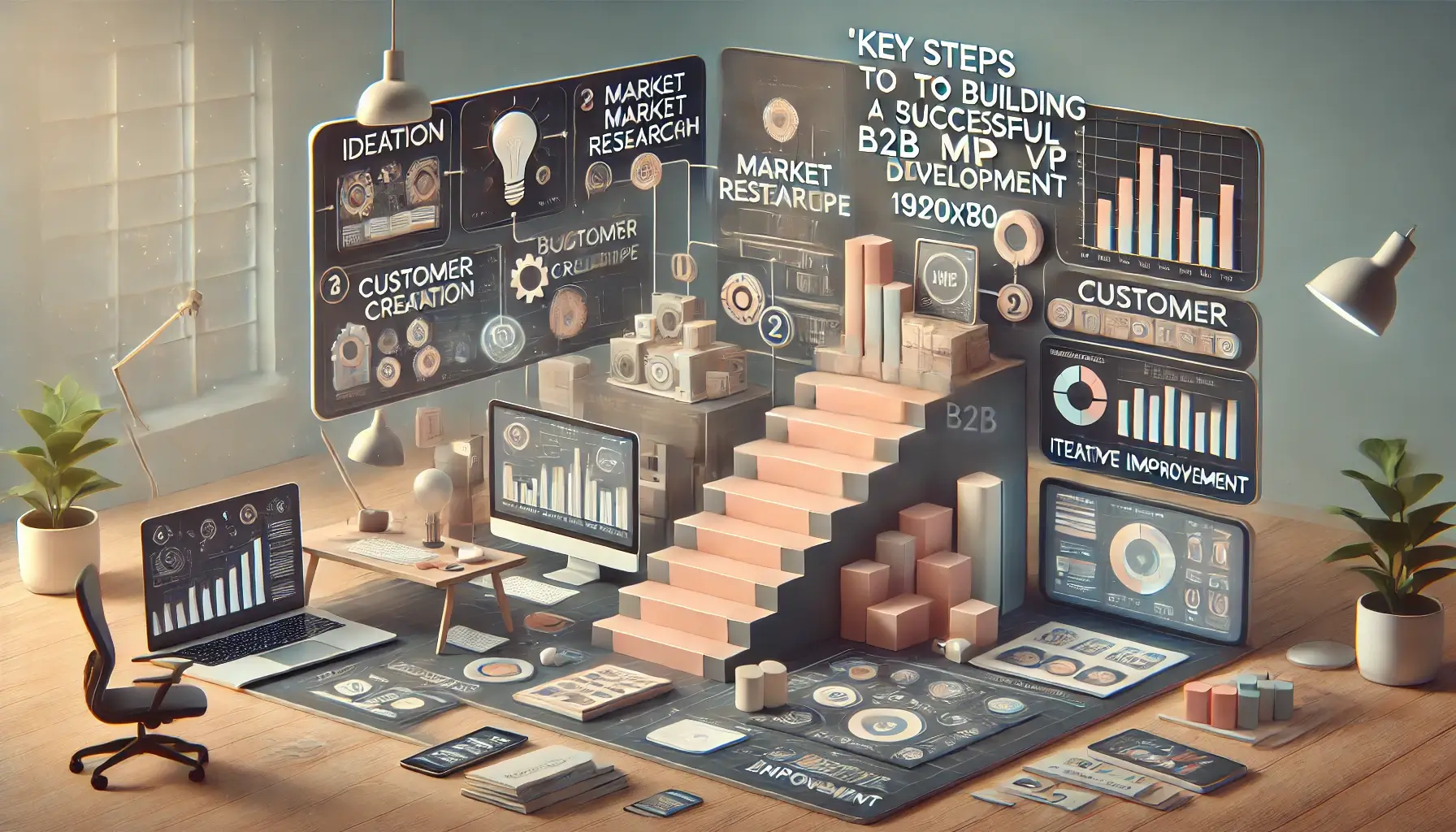
Developing a successful B2B MVP requires a considered and balanced strategy regarding functionality, scalability, and actual business value. Unlike B2C MVPs, the success of which relies on fast user adoption and rapid iteration, a successful B2B MVP needs to be strongly targeted, well validated, and prepared to work within complex enterprise ecosystems. Here are the major steps for developing a successful B2B MVP:
The first part in creating a B2B MVP is deep analysis and validation in the marketplace. Unlike in consumer markets, whose trends can overnight reverse, B2B markets require meticulous analysis in an effort to verify that a real, immediate demand for the solution actually exists. Customer interviews, competitive analysis, and studies in industries have to be conducted by startups in an effort to understand pain, buying processes, and existing gaps in the marketplace. Validating demand is the target, with no development investment being incurred in advance.
Once market validation is finished, then comes defining the key problem your MVP will address. Unlike in B2C, in which an MVP can go to market with a feature set that appeals to general use cases, a B2B MVP must address a single, mission-critical issue for companies. Enterprise buyers don’t implement tools for minor conveniences—instead, they require tools that save them time, save them money, make them work smarter, or generate new revenue. Successful B2B MVPs deliver one, two, at most, key capabilities that address a high-value issue, and not a tool that is a jack-of-all-trades.
With a problem statement in mind, the following is to develop a secure and scalable MVP architecture. Unlike software for consumers, which can use lightweight infrastructure at launch, software for B2B can have integration, security, and scalability in mind when developed. Most companies have information protection requirements, compliance requirements such as GDPR, and integration with existing enterprise infrastructure requirements. Not having integration and security in mind at launch can make securing enterprise buyers complex.
Once the MVP is constructed, testing and feedback loops with buyers follow, an important subsequent step. Unlike consumer-facing apps, whose buyers can leave feedback in app stores and social networks, buyers in a B2B environment require guided onboarding, training, and service afterwards. That requires working with early buyers in a hands-on environment to gain feedback, iterate over feature sets, and validate value for the MVP. What one wants to do is establish trust with early buyers, iterate over real business requirements, and build case studies attesting to the effectiveness of the product.
The final stage is preparing for scale. Because an MVP is intended to act as a launch point, B2B companies will have a concrete path for feature expansion, performance enhancements, and attracting larger-enterprise customers. That entails planning for role management for users, performance optimizations, automation, and integration through APIs in preparation for dealing with increased demand.
At DM WebSoft LLP, we make it possible for companies to develop, launch, and scale successful B2B MVPs that work and are marketplace-ready, both functionally and strategically. In the section below, we will explore general problems in creating a B2B MVP and resolving them.
Common Challenges in B2B MVP Development
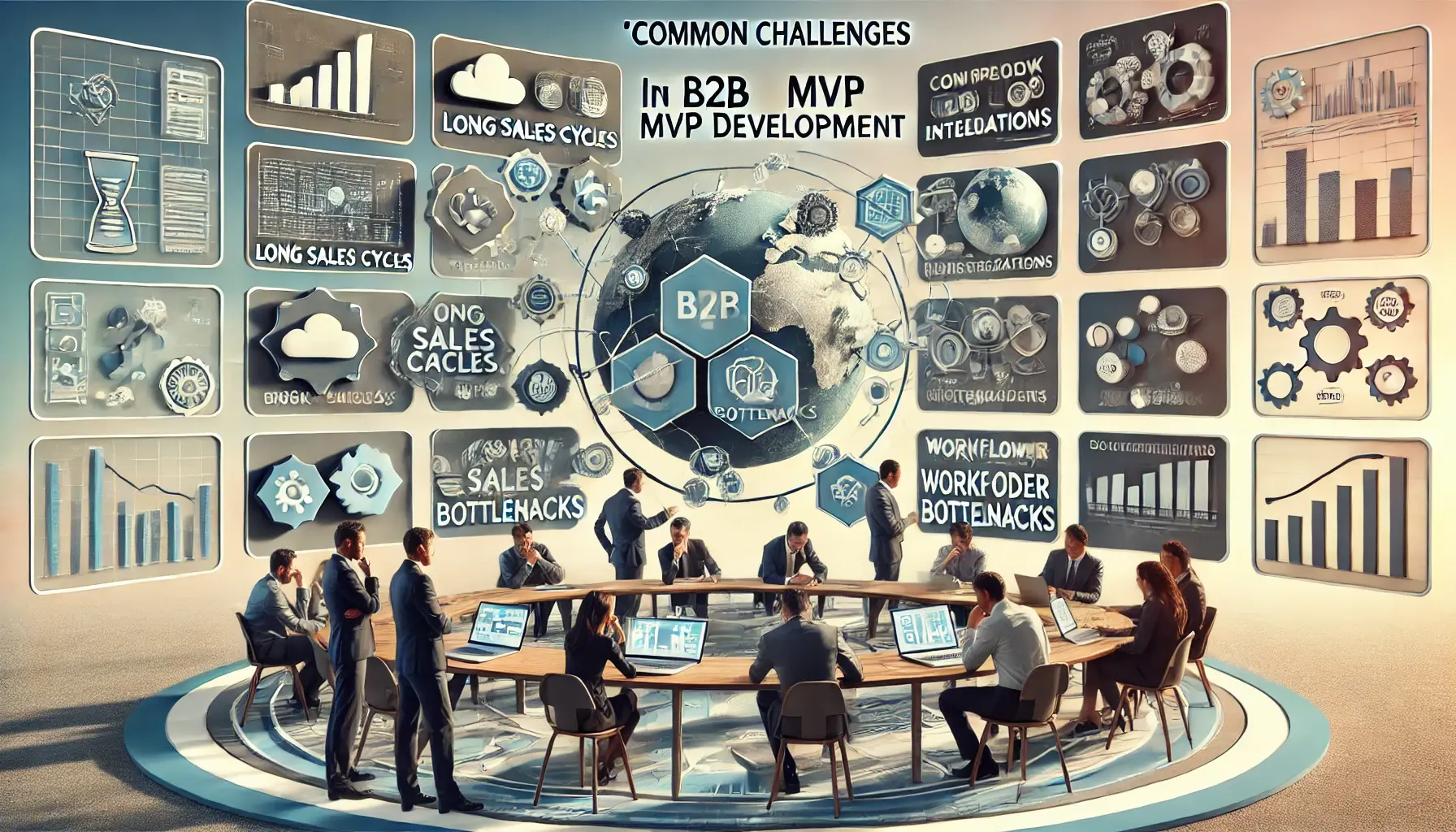
Developing a B2B MVP comes with its specific challenges, and most startups miss out on them. Unlike with B2C products, whose quick launch and development can count on feedback from an ocean of users, a B2B MVP will require a measured, planned path towards traction. With no planning, companies can fall victim to slow adoption, long sales cycles, and a poor product-market fit. Some of the most common obstacles in developing a B2B MVP and overcoming them include:
One of the biggest challenges in creating a B2B MVP is over-engineering the product’s first version. Most B2B startups have an urge to build a completely finished, feature-complete solution first, but it is counterintuitive to the entire MVP principle. Rather than trying to build an overall enterprise solution, startups need to build one or two essential capabilities that solve a critical issue for businesses. What matters most is providing value with a minimum amount of development work—not creating an all-things-to-all-people platform at the outset.
Another significant issue is dealing with long and complex B2B sales cycles. In contrast to B2C items, in which one can sign up and start utilizing the product, in most cases, B2B sales involve a lot of stakeholders, long decision times, and negotiations. That is, even with a working MVP, early customers must be won over, and it takes a long time. To counteract that, startups must target early adopters in their marketplace—firms that are actively looking for a solution and willing to try new products out. Building strong relationships, offering pilot programs, and demonstrating ROI early can enable companies to drive accelerated adoption.
Customer validation is yet another challenge most B2B startups encounter. Unlike app stores and social networks, where quick feedback can be received for B2C offerings, for B2B offerings, a more structured feedback loop is present. There is a need for companies to work actively with early adopters, conduct in-depth interviews, and iterate over features based on real business requirements. In its lack, one stands a chance of creating an MVP that fails to represent actual industry requirements. Successful B2B startups integrate early and ongoing feedback from customers, and the product can develop according to real-life business use cases and not hypotheses.
Scalability is one of the key areas in which most B2B MVPs lack, and for a reason: Enterprise buyers demand solutions with high capabilities in terms of processing big datasets, supporting several types of user roles, and integration with current infrastructure with ease. In case an MVP isn’t designed with scalability in mind, companies can face difficulty in moving early adopters to full-fledged enterprise use cases. To circumvent such a scenario, B2B MVPs must have a sound technical backbone, even in its infancy stage. That involves secure data management, integration capabilities through APIs, and an infrastructure capable of supporting future expansion.
Finally, pricing and monetization can become a challenging problem for B2B startups. Unlike with B2C goods, for which low-cost subscription pricing or freemium is prevalent, pricing for B2B must be precisely designed in a form that reflects accurately the value of the solution. Most startups undervalue their MVP, offering free trials for a long duration, and price too low. Instead, one must experiment with alternative pricing structures early, make transparent ROI estimates, and implement tiered pricing for companies of all sizes.
At DM WebSoft LLP, we specialize in guiding companies in overcoming such challenges through developing functional, scalable, and market-ready B2B MVPs. In the section below, an analysis will be performed about how Agile development is imperative in success with a B2B MVP.
The Role of Agile Methodology in B2B MVP Development
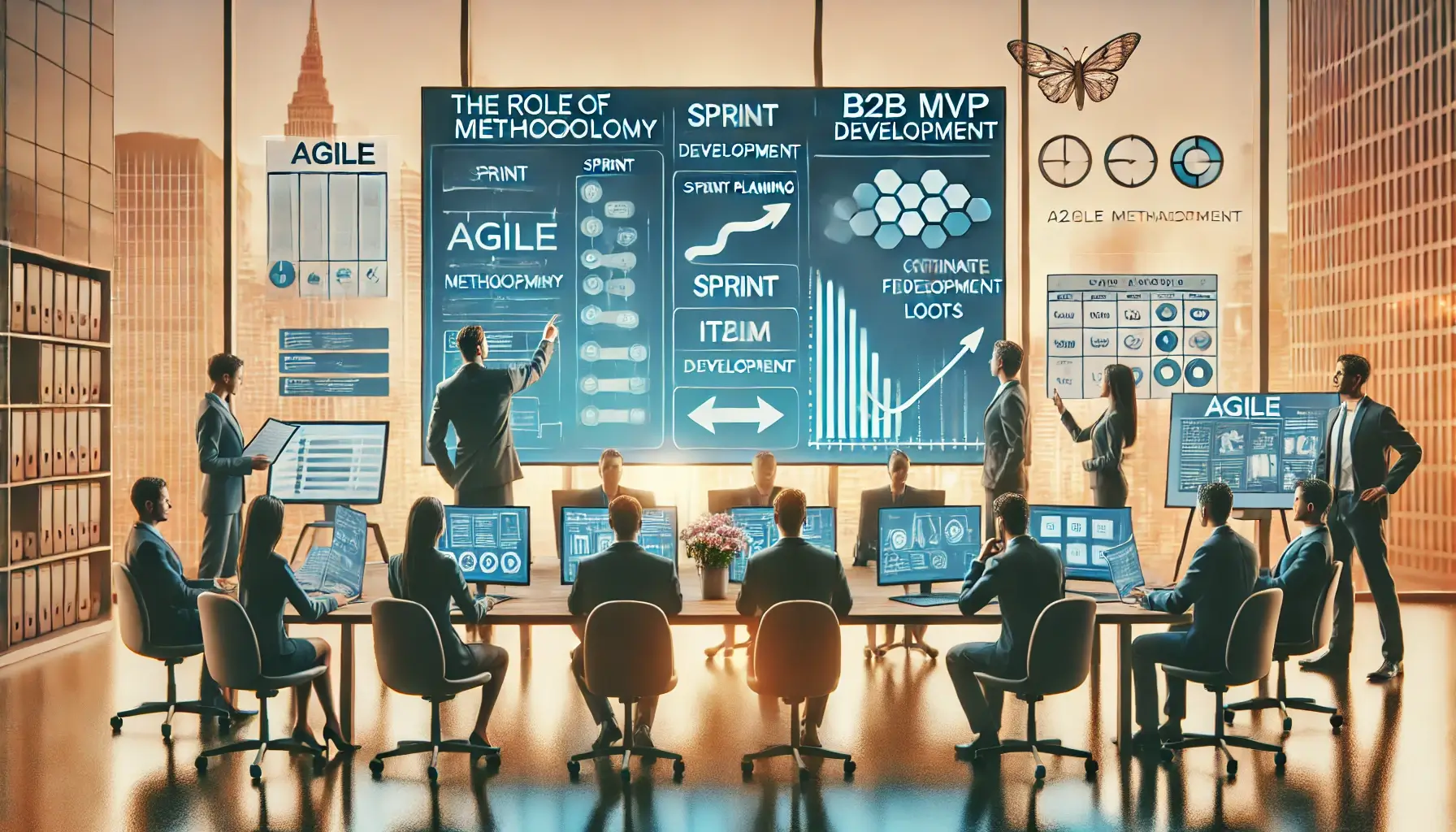
Building a B2B MVP isn’t shipping a barebones version of a product, but iteratively developing it with real-life feedback, enterprise requirements, and shifting marketplace demand. That’s when Agile development comes in. In contrast to traditional, rigid development methodologies, Agile helps startups iterate, validate in real-time, and react to shifting business requirements.
One of Agile’s biggest assets when creating an MVP for B2B is its iterative character. Instead of spending months (years, even!) developing a perfect product and shipping, Agile encourages companies to launch little, working pieces, receive feedback, and adjust features in terms of actual use. In such a manner, with each development phase, the product is getting a little bit better, and its direction is getting nearer to its enterprise customers’ needs.
Agile also deals with requirements complexity in B2B software. Unlike with B2C apps, whose basic requirements make them less complex to build, B2B software integrates with existing enterprise infrastructure, adheres to compliance requirements, and handles multi-user workflows. With Agile development, critical features can be prioritized, integration can be validated, and unplanned impediments can be addressed without jeopardizing overall direction.
Another key benefit of Agile in MVP development for B2B is its efficiency in managing a long sales cycle. Since buyers in B2B spend a lot of time evaluating a product for purchase, Agile helps startups deliver critical functionalities in phases, with early adopters benefiting early and additional ones developed through feedback gained from them. Incremental delivery keeps companies in contact with target buyers, with constant improvements displayed, generating trust.
The Agile model also encourages effective collaboration between early adopters, developers, and stakeholders. Frequent feedback loops through week-by-week sprints, testing with real users, and demonstration sessions ensure that development stays in harmony with actual customer requirements and not with hypotheses. By adhering to such a model, unnecessary feature development is circumvented and high-value impact delivery is prioritized, driving business value.
Finally, Agile development helps companies effectively scale an MVP. After traction with a first product is gained, Agile helps groups build out capabilities, streamline performance, and introduce sophisticated capabilities in a manner that doesn’t cause a significant disruption. That kind of adaptability is critical in B2B environments, in which changing customer expectations and changing enterprise requirements over time arise.
At DM WebSoft LLP, we use Agile methodologies to allow companies to build, streamline, and scale their B2B MVPs with efficiency and accuracy. In the section below, a real case study will be presented regarding how DM WebSoft LLP helped a B2B client implement a scalable MVP.
Case Study: How DM WebSoft LLP Helped a B2B Client Launch a Scalable MVP
How to Validate a B2B MVP Before Full-Scale Development
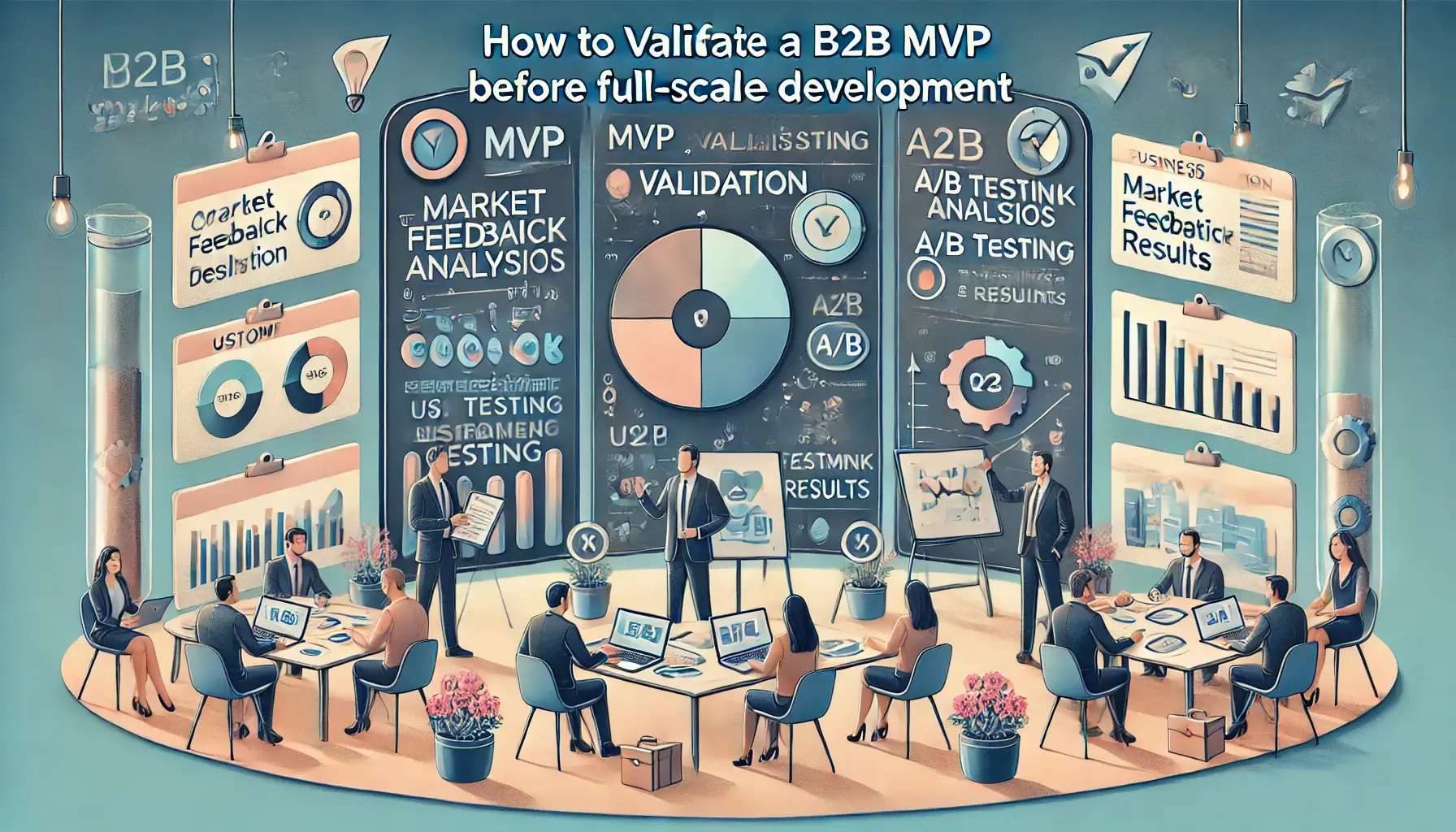
One of the biggest mistakes that B2B startups make is overinvestment in creating a product first and then validating with real buyers subsequently. Unlike in B2C goods, in which a minimum viable product can make headways through quick use by buyers, B2B solutions require deep validation, measured testing, and direct interaction with buyers. In its lack, startups have the risk of creating capabilities that companies don’t necessarily need, and thus, slow adoption, wasted resources, and failed launches.
The first and most critical part of proving a B2B MVP is proper market analysis. As straightforward and logical a statement that it is, many startups have a misguided view that seeing a problem, companies will pay for a solution naturally. In reality, buying in a B2B scenario is a multi-faceted issue, and companies have numerous workflows, traditional processes, and budget constraints in place that will affect adoption. Startups have to chat with potential buyers, go through industry reports, and study competition in order to ensure that their solution addresses real pain and business goals.
Once the opportunity in the marketplace is determined, then comes the part of getting early adopters involved even prior to development taking off. Unlike with consumer-facing apps, for which one can validate product-market fit post-launch, B2B MVPs can validate early through pilot programs, customer advisory boards, and prototype demonstrations. Startups can develop clickable prototypes, interactive mockups, or even service-manual versions of software and utilize them in testing demand even before investing in full-fledged development. Successful B2B startups have gained first-paying customers even before a single line of code is ever written, a fact that bears witness to the fact that their idea is worth investing in for companies.
The other critical component of B2B MVP testing is the minimum viable feature set. As companies expect functional and dependable tools from launch, startups must ensure that their MVP covers business-critical capabilities but not at the expense of unnecessary complexity. Instead of building a big feature set, startups should focus on resolving one or two high-priority pain areas with immediate ROI. Involving pilot customers during development helps startups prioritize must-have capabilities and avoid over-engineering unnecessary capabilities.
Startups should use proof-of-concept projects to pilot-test their MVP in real working environments for real-life testing. Deploying a pilot in a target client’s operations at a small level can unveil usability, integration, and workflows, offering valuable information about these aspects. By following such an approach, B2B startups can fine-tune their offering and deliver real value to future buyers, raising their chance for closing long-term enterprise deals.
Finally, tracking key metrics for validation keeps startups on the right path. Metrics including activity of customers, feature use, free-to-paid conversions, and ROI-driven impact allow one to assess whether an MVP is delivering desired objectives. In case early adopters can not see value, startups have to adjust positioning, pricing, or offering prior to expansion.
At DM WebSoft LLP, we validate MVPs of B2B startups through pilot testing, market studies, and iterative development, and then make them launch solutions that respond to enterprise needs. Not only does a thoroughly-tested MVP verify that a product is functional, but it creates a sound basis for long-term success in a business.
Conclusion: Why B2B Startups Need a Different MVP Blueprint
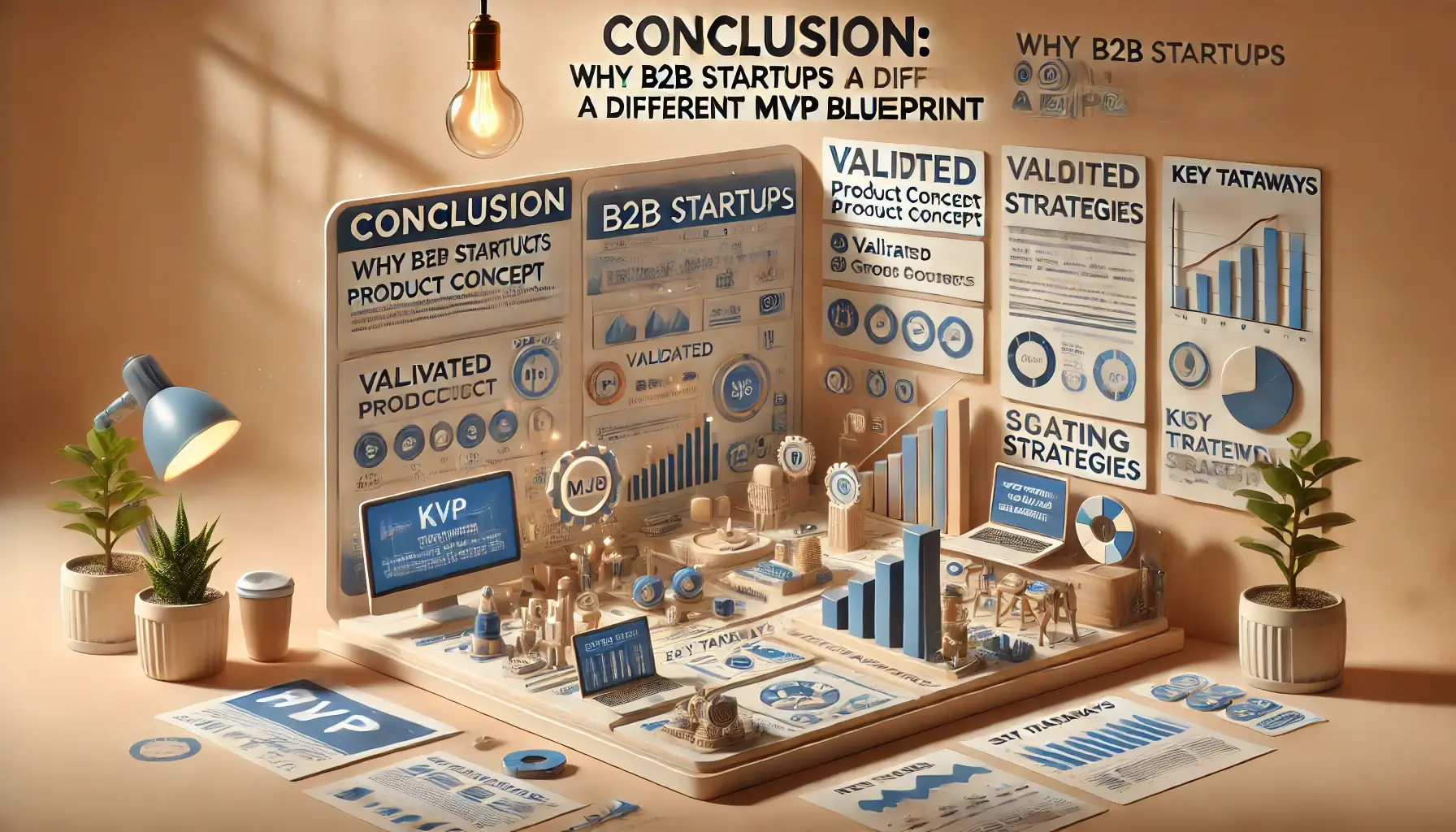
Building a B2B MVP isn’t shipping a barebones version of a product, but developing a high-leverage, scalable solution that can tackle real business problems starting day one. Unlike B2C startups, who can afford to tinker with big consumer bases, B2B startups must prioritize enterprise-class capabilities, deep customer testing, and long-term scalability.
The key is that B2B MVPs have a new playbook. Where in a consumer-facing MVP, one maximizes looks, virality, and consumption at a high level, in a B2B MVP, one maximizes business-critical capabilities, integration, and ROI demonstration. That is:
- Identifying a specific, mission-critical problem and resolving it successfully.
- Building a thin but strong MVP that creates actionable business value.
- Navigating long sales cycles with early adopter involvement and ROI demonstration.
- Ensuring scalability and security to meet enterprise expectations.
- Employing Agile development to iteratively build and refine the product based on real customer feedback.
The companies that can successfully deliver successful B2B MVPs are ones that strategize, iterate intelligently, and validate regularly. DM WebSoft LLP helps companies navigate through the specific challenges of creating a B2B product, enabling them to launch scalable, market-ready MVPs that drive success for the business.
Ready to build a standout MVP for your B2B? Get in contact with DM WebSoft LLP and let’s build a personalized, high-impact solution that can drive your business success.
A B2B MVP focuses on solving specific business problems with core functionality, while B2C MVPs often prioritize user experience and mass appeal.
Enterprise clients expect solutions that can handle large user bases, secure data management, and seamless integrations, making scalability essential from the start.
DM WebSoft LLP specializes in building strategic, scalable MVPs that meet enterprise needs, ensuring long-term success for B2B startups.
Agile allows teams to iterate quickly, validate features, and adapt to client feedback, ensuring the MVP evolves to meet real-world demands.
Focus on solving one or two mission-critical problems for your target audience and gather feedback from early adopters to refine your approach.
Get Started Now !
What’s the Process ?
Request a Call
Consultation Meeting
Crafting a Tailored Proposal
Get Started Now !
Real Stories, Real Results. Discover What Our Clients Say

Working with DM WebSoft LLP was a game-changer for our business. Their technical prowess and innovative solutions transformed our online presence. A highly recommended web development agency with a stellar track record.

We are thrilled with the results DM WebSoft LLP delivered. Their deep understanding of web development coupled with years of expertise ensured a seamless and visually stunning website. True professionals!

In a digital age where first impressions matter, DM WebSoft LLP crafted a website that speaks volumes. The team’s attention to detail and commitment to quality set them apart. Thank you for making our vision a reality.

DM WebSoft LLP’s team demonstrated unparalleled expertise. Their ability to navigate complex technical challenges with ease is truly commendable. Choosing them for our web development needs was the best decision.

Exceptional service, unmatched skills! DM WebSoft LLP stands out as a leading web development agency. Their collaborative approach and commitment to excellence make them our go-to partner for all things web-related.

DM WebSoft LLP turned our ideas into a digital masterpiece. The seamless communication and timely delivery of our project showcased their professionalism. Highly impressed with the level of creativity and skill.

Our experience with DM WebSoft LLP was nothing short of amazing. From concept to execution, their team provided top-notch web development services. A reliable partner for businesses looking to elevate their online presence.

DM WebSoft LLP’s team of tech experts is second to none. Their wealth of experience reflects in the quality of their work. Our website not only meets but exceeds industry standards, thanks to their dedication.

Choosing DM WebSoft LLP was the best investment for our web development needs. Their team’s proficiency, coupled with a customer-centric approach, made the entire process smooth and enjoyable. A pleasure to work with!



